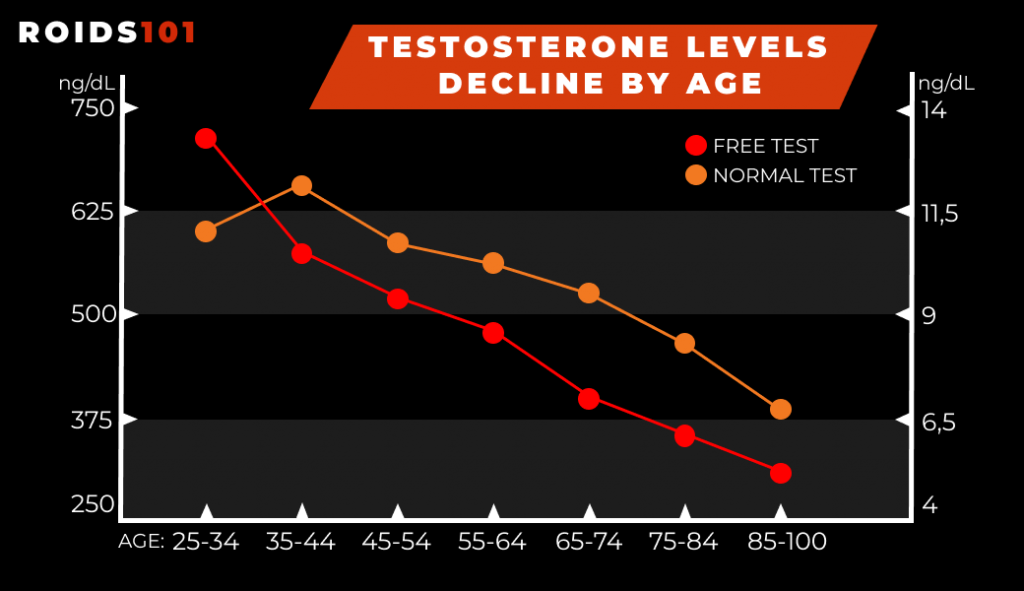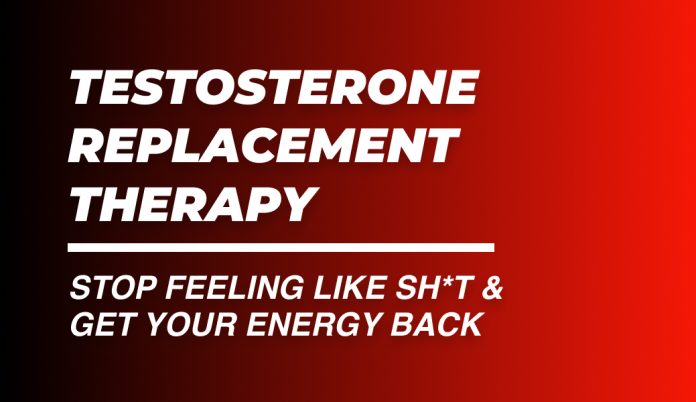When you start researching TRT yourself, you can get overwhelmed by the number of figures, options, arguments, pros and cons, studies, and so on. It’s a big topic. Besides, it’s a $1,8 Billion industry, so the marketing tricks also play their role here.
We’ve got you covered. Here’s Roids101 Ultimate Guide to TRT. All data is fresh and relevant in 2022 – enjoy the read.
- What is Testosterone
- What is TRT
- Reasons to Start TRT
- Hypogonadism and Low Testosterone
- Do You Have Hypogonadism?
- Age to start Testosterone Replacement Therapy
- Other reasons for TRT
- Testosterone Replacement Therapy Benefits
- Official or Self-Prescribed TRT?
- Best TRT Compounds
- TRT Dose
- TRT Myths & FAQ
- TRT Side Effects
- TRT Risks
- Personal Opinion on Testosterone Replacement Therapy
What is Testosterone
First of all – some basics. Testosterone is the primary male sex hormone that is produced in your balls. Basically, it is what makes you a man. Testosterone is responsible for a vast number of your life aspects, from muscle mass and facial structure to sex drive, mood, and temper.
What is TRT
The abbreviation stands for Testosterone Replacement Therapy. It’s a treatment that originated in the 1930s when scientists first created synthetic Testosterone. It’s a part of a larger treatment kind, HRT (Hormone Replacement Therapy).
Deficiency of certain hormones can lead to health risks, various shitty conditions, and an overall decrease in the quality of life. If your body – for some reason – decided to lower or stop the natural production of a specific hormone (endogenous production), you can fill the gap with special medication – exogenously. It’s an official, FDA, and Health Canada-approved thing that your physician can prescribe. It’s well-researched as well.
Reasons to Start TRT
If you even think about TRT – you probably have some reasons for it. The good news is – you’re not alone. The most common reason for men to get TRT – hypogonadism – reportedly affects about 30% of ALL men worldwide, aged 40 to 79. And it’s just the most popular reason.
Hypogonadism and Low Testosterone
Hypogonadism is a fancy name for your body’s inability to produce enough Testosterone. You can get it from birth; it can develop over time by your 40s; it can be caused by anabolic steroids abuse, triggered by mental conditions, unhealthy lifestyle, or even stress.
Do You Have Hypogonadism?
Here’s how you can detect hypogonadism without going to the hospital for checks:
- Do you feel depressed all the time for no apparent reason?
- Do you have problems with erections?
- Do you feel that your sex drive got lower or even vanished completely?
If all three answers are a sad «Yes» – take a look at additional red flags:
- Do you sleep badly?
- Do you feel fatigued during the day and get insomnia in the night?
- Do you have problems with your body hair – like, you can’t grow a beard?
- Do you – by medical means – know that you have fertility issues and low sperm count?
- Do you feel like working out gives you zero growth and results?
- Did your bones get weaker?
- Did your nipples turn way too sensitive and possibly turned into moobs (aka male tits, aka gynecomastia)?
All of these problems can be caused by hypogonadism. None of them is a 100% indicator, but when you get more than just a couple – it might be a sign that you need TRT. And to make sure that everything goes smoothly we recommend to buy TRT in our store. In this way we can make sure that you’ll get the purest compound on the market and won’t hurt your health by buying from malicious sellers.
Make sure you get an actual medical check and blood work before self-prescribing anything based on a dozen of questions from an Internet article, ok?
Age to start Testosterone Replacement Therapy
The short answer: no age requires anything like mandatory TRT. Though at your 40s, you’re more likely to feel the symptoms of low Testosterone, and therefore – considering TRT.
Long answer: Your testosterone level is closely linked to your age. 35-44 is the range when it starts to decline rapidly. Here’s a graph:

So, does it mean that you can’t get TRT in your 20s? Of course, you can – if your Testosterone is seriously lower than normal.
Other reasons for TRT
You can’t say, «Oh, I have depression and social anxiety, I need TRT», or «Man, my sex life is a mess for the last few months, I need TRT».
There’s just one reason to start Testosterone Replacement Therapy: it’s low Testosterone.
You can see a whole bunch of articles on the Web that give you lists like this:
- Depression;
- Low libido;
- Muscle Mass Loss;
- Balding;
- Erection issues;
- Reduced bone mass;
- Body fat % increase…
And so on. Those articles are made for a sole purpose: they want your clicks and want your appointment at the clinic that provides the article.
- You can have low libido because SOMEONE you married years ago got fat and yells at you too much;
- You can have depression because your work-life balance is shit;
- You can lose bones density because of osteoporosis;
- You can get bald because you’re genetically predestined to, and all men in your bloodline got bald by their 40s;
- Your muscle mass can decrease because your daily activities consist of walking from the bed to the kitchen, your car, your office chair, and back, with zero exercising and 90% sitting on your butt.
None of these are reasons to start TRT, but all of them are reasons to get your Testosterone checked. Simple stuff, but it’s often misinterpreted to get more people to TRT. Just look at the number of private clinics that offer it.
Testosterone Replacement Therapy Benefits
The main obvious benefit is combating low Testosterone. Here is what it means practically:
Sex Drive Boost
The effects of low Testosterone on libido were proven multiple times in studies like this one from The Journal of Clinical Endocrinology & Metabolism. It’s, like, kind of undeniable by now.
What’s more important – TRT is proven to fix the problem. Here’s the study from 2019 that highlights the results. Even better – TRT is proven to counter erectile dysfunction as it is. So practically:
- Your erections get better and easier to maintain;
- It gets way easier to get an erection in the first place;
- Your sex drive and desire to have sex goes back to normal;
- Your performance in the bedroom gets better, you can last longer (a bit, but still).
If you’re about 25 or 30 and reading this – you might underestimate how significant these benefits are for 40-50-something-years-old guys. Especially if they were cycling AAS all their life with no proper PCT and ancillaries.
Mood and Self-esteem
«Now I know I’m being used
That’s ok, man, ’cause I like the abuse
I know she’s playing with me
That’s ok ’cause I got no self-esteem»
— The Offspring Lyrics
Yeah, The Offspring were up to something. Thankfully, the guy from the song didn’t know shit about TRT – otherwise, he wouldn’t have issues like that.
Testosterone is proven to boost your self-confidence, but get it right: it doesn’t turn your introverted ass into a total Chad-like walking magnet for ladies. In the same study, you can find a highlight that shows: no correlation between increased Test levels and frequency of sexual intercourse.
Keep your expectations realistic – that’s what you can get:
- Less social anxiety;
- It can be easier to initiate a small talk;
- It’s easier to suppress fear and anxiety in responding to aggression;
- You feel more confident in your achievements and decisions;
- It’s easier to make a decision and stand for it.
Just don’t make it to OVER-confidence – it’s not a good thing, and you can get depressed because of unrealistic expectations about your performance. It’s also linked to Testosterone levels, as they show here, in another paper.
Better Performance in the Gym and Less Fat
Isn’t it, like, the whole point of steroids? Well, TRT works in the same way – just less notable, and with one key difference:
Bodybuilding doses of Testosterone can vary from 300 to 700 and 1-1,5g of Testosterone EW in short cycles;
TRT doses of Testosterone rarely exceed over 200mg, and the «cycle» can last for months, if not years.
Here you can get our guide to Testosterone in Enanthate ester. You’ll find all the links to proofs and data there. The performance benefits that you can expect from TRT are precisely the same – just seriously less pronounced:
- Muscle growth;
- Strength boost;
- Endurance increase;
- Better pumping effect;
- Fat tissue decrease.
Fat is just another key feature: the more Testosterone you get – the slower your fat tissue growth is. The following decrease in Estrogen also cuts your chances to get the «female» type of fat tissue placement – like on your belly, in your breasts, and on your hips. Here’s a study that shows the direct connection between Testosterone levels and Fat distribution.
These are the primary benefits of TRT. It’s still widely researched, so maybe, in the future, we’ll see new things – like COPD (pulmonary disease treatment) treatment – on the list.
Official or Self-Prescribed TRT?
Even though it’s legal in most countries, sometimes the process itself is… say, not what you really need. Here are the reasons people prefer to self-prescribe TRT:
- Black market testosterone is cheaper than FDA-approved TRT gel compounds;
- Depending on your location, it can be pretty expensive to get all the papers needed to start official TRT;
- Even a regular visit to a physician can be pricey for some – we all have different income, insurance, and so on;
- Official TRT might be insufficient for your targets;
- Some doctors may refuse to prescribe you TRT because of age, analysis results, limitations, legal stuff, and so on. Medicine is 50% paperwork nowadays, and it’s a barrier some refuse to deal with.
Money, bureaucracy, legal stuff. The three pillars of the «Fuck it, I’ll prescribe it myself» approach.
Important note: there’s no practical difference between self-prescribed and officially prescribed TRT. Here’s a study that shows how minor the differences are.
Before you decide to opt for the latter – read more about the compounds you may need. Also, don’t start hating on health institutions (it’s always a bad idea). Sometimes Health Canada publishes nice-wrapped warnings on dangerous pseudo-TRT compounds. Some are, basically, poison, and some are just anabolic steroids, labeled as something else.
Most AAS will be an overkill if your target is a simple TRT.
Best TRT Compounds
The shortest answer here would be «Anything with Testosterone, duh», but it’s not exactly right. There are 4 types of compounds for TRT now:
- Pills;
- Pellets;
- Gels and patches;
- Injectable compounds.
At least these 4 types are the most often used nowadays. The list of compounds you can use is gigantic, but mainly because the compound names will vary from country to country. Here are the most popular ones:
- AndroGel;
- Action;
- Fortesta;
- Testim;
- Vogelxo;
- Bio-T-Gel;
- Testosterone Enanthate;
- Testosterone Cypionate;
- Testosterone Decanoate.
Looks like a damn lot of compounds, given that you need to choose just one, right? We’ll help you with that a bit.
First — you can check out TRT by Apoxar in our shop (which is, to put it simply, just the way Apoxar decided to call injectable Testosterone Decanoate in its pure form). It’s one of the longest esters available on the market, so it’s a perfect Hormone Replacement Therapy compound.
Now, to give you more info — let’s deal with the type of the compound. Aside from pills (mostly unpopular and more than mildly liver-toxic), you have just two ways to administer the compound: intramuscular (injection) or transdermal (through the skin, gels, and patches). Here’s which one – in our opinion – is more reliable (and why).
TRT Gel vs. Injections
It’s a long-ass argument in the community, but most people are on the injections side. Here’s a side by side comparison:
| Testosterone Gel or patches | Testosterone Injections | |
| Price | Expensive | Mostly cheaper |
| Safety | FDA and Health Canada approved pharm-grade compounds | Depends on your source, can be shit, can be a high quality thing |
| Dosage | Easy, t’s a gel | Demands precision and a bit of skill |
| Frequency | Should be applied daily | From 2x a week to 1 time in 2-4 weeks, depending on the compound (such rare injections are sometimes prescribed, but not recommended though) |
| Pain | Zero | Depends on your skill and experience, mostly mild |
| Effectiveness | Affected by a lot of factors, sometimes unpredictable | Effective if you get the right dose |
| Natural effect | Can mimic natural Testosterone level changes throughout the day | Can’t mimic shit, just works, peaks and dissolves |
| Dangers | Mild (perosnal intolerance) | Mild (infection or PI) |
| Anecdotal experience | Usually prescribed first, but ineffective | Effective, worth mastering all the necessary aspects of it, but more demanding in terms of practice |
I understand that this table may look a little biased (since it’s based on anecdotal experience and some factors that you can’t precisely measure).
The price range and quality of the compounds available can vary depending on your location, so your own research is strongly encouraged here.
TRT Dose
The short answer is: 100-200mg/week, with 125-150mg as the sweet spot for most.
Long answer: It really, really depends on the compound. With the most common Testosterone Enanthate/Cypionate injections, the most common dosing and protocol would be 50-100mg 2 times a week. Not going to make this part long, because really – it depends on the compound you decide to go with.
Besides, there are multiple opinions, and it’s a sort of individual thing. Some men feel good on 200mg injections once a week, some prefer to break it in parts, some are fine with 1 huge 600-700mg long ester injection a month (yup, it’s prescribed sometimes).
TRT Myths & FAQ
Before we get to the side effects part – it’s important to deal with some misconceptions. Here they are, one by one.
TRT Side Effects
I hope you didn’t expect a free ride! TRT – like any other hormone replacement therapy – can give you some side effects. CAN here should be highlighted twice because MOST men are not experiencing these side effects. At least anecdotally. However, those nasty sides are still there, as a risk. The list looks like this:
- Oily skin;
- Acne;
- Headaches;
- Elevated BP;
- Chest pain;
- Nosebleeds;
- Messed up liver values;
- Sleep issues (insomnia or sleepiness during the day).
Chances that you’ll experience any of these are strictly individual. You can get the whole set or get a smooth ride and avoid every single side effect. It depends on your personal stats and health.
TRT Risks
It would be unfair not to give you some warnings. TRT is not something that every single man in history had to deal with. For many of us, it’s a new thing. That’s why you should approach it with knowledge of all the risks.
Major Risk 1: TRT For Life
That’s the main one. If you jump on the TRT train when you’re 45 or something, you’re most likely on TRT for the rest of your life. Yup, pinning or applying the gel daily or several times a week up to the point when you’ll simply die. Brutal, cruel, but honest thing. Stop it; you’ll end up in a worse state than you were before the TRT.
If you wonder how men can even go for it, you need to understand one important thing: if you get no TRT for life, you’ll get low Testosterone for life.
It’s not a choice between «injections with benefits» and «normal life». It’s a choice between «feeling like a total shit because of naturally declining testosterone levels» and «injecting it to save the situation at least a bit».
Testosterone deficiency affects not only your physical health. Mental health is proven to get the damage as well. Some athletes don’t even have to make the said choice – several years of overdosing and abusing anabolic steroids lead them to TRT for life… at 30 or even younger. That’s a shitty situation, but it’s the only way for some to live their old everyday life.
Major Risk 2: TRT Injections
Let’s be honest, you’re – most likely – not a certified physician, and you probably don’t know shit about intramuscular injections. If you do – it’s awesome, but I bet the majority of men didn’t have a chance to learn to do them correctly. Injections as a process bear several risks:
- Infection in the injection site;
- Hit the vein or an artery, and you’re fucked;
- Soreness, pain, itchiness in the injection site if you don’t change it frequently.
The good news is – it’s not the hardest skill to master. Here we have a step-by-step guide on a proper intramuscular injection. If you don’t like it in the text – go to YouTube. There are dozens of guides on intramuscular injections from legit medical institutions.
A little advice: disinfect everything TWICE to feel more confident and not worry about infections with every unusual tingling. And if you don’t want to do it the intramuscular way – you can go with subcutaneous, aka in the thin fat layer under your skin. Even though SOME Testosterone manufacturers say that their compounds are “intramuscular only”, anecdotally, we know that it’s not the case. Sub-q injections work just as well.
Personal Opinion on Testosterone Replacement Therapy
To keep it short: it’s a therapy, not a fun thingy you can take lightly, hop on and hop off in a month or 2. Real TRT will give you notable effects ONLY in 6-12 months. It can be dangerous, can stay with you for the whole life, can give you nasty sides, but it is – hands down – one of the best breakthroughs in modern medicine.
Yeah, it’s technically from the 1930s, but TRT has never been as accessible as it is now, with private clinics, all the research, the amount of information you can get for free on the Internet, and dozens of compounds on the market.
For many men, TRT is a life-saving thing. You can be one of them. Just make sure that you can’t save your life by any other means, don’t have any TRT no-go’s with your health, and most importantly – make sure that you’re ready for it.



